The improvement in ballet film from video to DVD has been colossal and welcome. The audio experience too has improved by leaps and bounds as it is more and more geared towards computers with earphones, rather than dodgy TVs. Hand in hand with technological advances has come a long-overdue new openness to recording by the Royal Ballet, which is now catching up with other leading world companies in considerable style. Here theartsdesk reviews significant new ballet DVDs plus some Christmas dance treats. Our reviewers are Ismene Brown and David Nice.
Even in a few years, standards of light sensitivity change, so that the viewing quality of something shot even four years ago can be drastically inferior to something shot this year. In Britisn ballet two major trends are obvious: the celebrating by Decca of the Carlos Acosta phenomenon and the linked but separate new initiative of the Royal Opera House to establish its own recording label Opus Arte to record fine-quality versions of its key productions for the audience that cannot reach London to see live performances. Most come in HD and Blu-Ray. Bonus features exist, but are not as yet dependably of bonus entertainment quality.
DVD of the Year
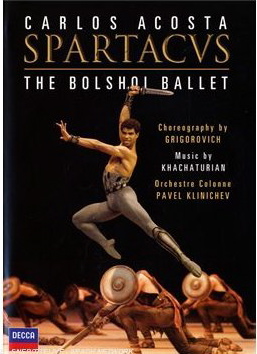 The Bolshoi Ballet: Spartacus (Khachaturian/Grigorovich) 2008, prod Grigorovich/Virsaladze, Carlos Acosta, Orchestre Colonne/cond Pavel Klinichev (Decca 2DVD 074 3303)
The Bolshoi Ballet: Spartacus (Khachaturian/Grigorovich) 2008, prod Grigorovich/Virsaladze, Carlos Acosta, Orchestre Colonne/cond Pavel Klinichev (Decca 2DVD 074 3303)
by Ismene Brown
Psychically as well as physically Spartacus must be the role of Carlos Acosta’s life - the black outsider of slave origin powering through a stage of northern white-skinned Russians in their own signature piece, and absolutely conquering. But it is more than a personal triumph: Acosta's performance (filmed on the Bolshoi's Paris tour, six months after the London premiere) had such irresistible integrity that it made Grigorovich's ballet a greater piece, gave it a fresh new dramatic potential that before had been overlaid by decades of politics and had turned it, for some Russians, into an object of suspicion and contempt.
The bonus feature is worth seeing first, as it underscores the potential for a drama where Spartacus actually doesn’t win. It opens with eloquent pictures of the Russian men doing what they know, barnstorming in breastplates, while Acosta sits in the wings looking tormented and a Russian speaks a few words of broken English to him. Language barrier, race barrier, class barrier - it’s the real thing that you see, in a sense, going on in this ballet. There is a telling clip of the ballet’s living-legend creator, Yuri Grigorovich, 30 years the director of the Bolshoi in the Cold War, listing the Soviet supermen who have danced the part and saying with a crocodile smile that he “will be interested” to see Acosta, whose grandparents were slaves while his were patricians. Truly they don’t make them like Grigorovich any more. Which is why it was such a risk that Acosta took on this most strenuously athletic of all male ballet roles at what’s relatively old age, in his mid-thirties, and why it’s moving and awe-inspiring to watch him at thrilling full stretch in it.
Some exceptional rehearsal film shows Acosta in the studio practising the fearsome split leaps with a grin on his face, more boyish and joyful even than in the stage shoot itself. As Nina Kaptsova, his Russian partner says, he shines with joy in this role, he glows. She adds, in this role Acosta shows his belief in a better world - and she’s right. That moral exaltation is what powers Acosta in this part and what makes this record of his incarnation the most exciting of this year's ballet DVD releases.
Kaptsova is more delicate and gentle a Phrygia than some have made Spartacus’s wife before, less the Madonna inspiring the hero, more the loving woman of the hearth, and her little body shapes those eyecatchingly acrobatic lifts that Acosta must hoist her in with refined elegance. The sexual charge from Acosta that she speaks of on the bonus radiates in their partnership, very yin and yang, like Khachaturian's night-club music.
In the roles of the “bad” pair, the Roman general Crassus and his concubine Aegina, the choreography is more extravagant, gestural and declamatory, which doesn’t help them so much in the scrutiny of the camera. Maria Allash is one of the great Aeginas on stage, more subtle and sophisticated in her seduction than the usual, but on camera this “live” gift of hers isn’t so clear. Alexander Volchkov pales in charisma next to Acosta; the Bolshoi lacks Crassus antiheroes in their ranks too, but then so would any company in this almost unperformable work, a theatrical one-off.
For the Bolshoi too, Acosta's triumph was theirs, since this is a ballet that’s not easy to sell as more than big, flash, macho spectacle. Several Spartaci have come and gone in the part since the last unmitigated hero, Irek Mukhamedov 20 years ago, without lifting the dead weight of Soviet caricature off the work. Acosta is the one man who has had both the supreme physicality for those gigantic demands, and who carried the dilemma of Spartacus as a man verily in his own soul, and transmitted it nakedly. This is blazingly evident on this recording. Buy Spartacus on Amazon
Royal Ballet DVD releases
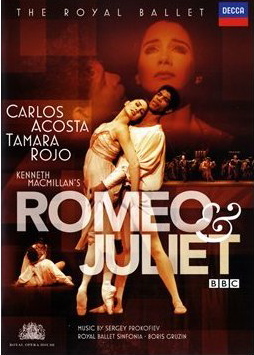 The Royal Ballet, Romeo and Juliet (Prokofiev/MacMillan) 2007, prod MacMillan 1965, Tamara Rojo/Carlos Acosta, Royal Ballet Sinfonia/cond Boris Gruzin (Decca 074 3337)
The Royal Ballet, Romeo and Juliet (Prokofiev/MacMillan) 2007, prod MacMillan 1965, Tamara Rojo/Carlos Acosta, Royal Ballet Sinfonia/cond Boris Gruzin (Decca 074 3337)
by Ismene Brown
This is a finely filmed record of a superlative artist, Tamara Rojo, in a role she has made her own, Kenneth MacMillan’s Juliet, partnered by the always irresistible Carlos Acosta. Rojo, known for her technical virtuosity in classics, also possesses an uncanny ability to make you live the story with her, a dance actress of heartbreaking power. Like the original Juliet, Lynn Seymour, she is luscious of figure and has delectable legs and feet. Yet from the beginning she conveys a Juliet of great youth and undevelopment, a blank page awaiting life’s experiences, which gradually uncover an unsuspectedly epic and unforgettable character. She radiates docile shyness in all her early steps with her parents, before a crackle of self-discovery when Romeo looks her ardently in the face for the first time. Rojo’s head snaps back, she almost faints with the shock of a new world, and with this tiny physical insight you feel with her that there is no going back.
The ballet action gains much from the camera, because MacMillan always thought cinematically and the clever director Ross McGibbon (once a dancer with MacMillan) is totally attuned to this. Camera cuts make something very special of Romeo’s solo when Juliet plays mandolin for her friends - again and again the shot slices between Rojo's disbelieving joy and Acosta wheeling around her, it’s a bubble of young happiness captured perfectly on film that on stage can be lost in the general view.
Acosta took a long time to agree to dance Romeo, and one still senses he knows this is not quite his role. He is not really an actor of narrative, more a great embodier of qualities (as in Spartacus above). He doesn’t instantly register in the opening serenade to Rosaline the urgent risk-taking personality that Johan Kobborg or Nicolas Le Riche has stamped on that very Shakespearean scene. But no one can surpass the Cuban in virile handsome romantic dancing, and the balcony scene is an exultant, captivating hurricane of young love.
The heavyweight among the male actors is Thiago Soares’ remarkable, vicious, bullying Tybalt (more at home in this character part than as Siegfried on the Royal Ballet’s Swan Lake recording below), but there is all round a lively sense of the individual dramatic personality that the Royal Ballet is supreme at generating.
Boris Gruzin conducts the Royal Ballet Sinfonia safely, if rather funereally in places, following the choreography rather than leading it, but it is a warm earphone experience. There is no bonus feature, but this is very highly recommended. Find Romeo and Juliet (DVD and Blu-Ray) on Amazon
 The Royal Ballet, Swan Lake (Tchaikovsky/Petipa/Ivanov) 2009, prod Dowell 1987, Marianela Nuñez/Thiago Soares, ROH Orch/cond Valery Ovsyanikov (Opus Arte OA 1015D)
The Royal Ballet, Swan Lake (Tchaikovsky/Petipa/Ivanov) 2009, prod Dowell 1987, Marianela Nuñez/Thiago Soares, ROH Orch/cond Valery Ovsyanikov (Opus Arte OA 1015D)
by Ismene Brown
I am not persuaded it is possible to film Swan Lake successfully. Surreality is an essential component of its spell, the live duende that descends suddenly on a moment when music, dance, idea and performer fuse, and the hair stands up on the back of your neck in the theatre. The camera is not a tool to seek out the fourth dimension. It chats to you like a friend, tells you what to watch here, what not to miss over there, offers you a constant multiple choice. So my reservations about this new DVD of the Royal Ballet’s current production are at least partly to do with the very vernacular way Ross McGibbon has filmed it.
In some ways his naturalistic camerawork makes this production by Anthony Dowell more attractive on screen than it feels in the theatre; what comes over on stage as frantic and distracting busyness works better when incidental faces and incidents can be singled out by the camera, and those who like their ballet demystified and very colourfully designed will be rewarded. Yolanda Sonnabend’s extravagant late-19th-century Fabergé designs look gorgeous in close-up, though her sets tend to vanish into the dark behind the players.
Act 1 glows brightly as filmed action, crowned with a superb performance of the first classical setpiece in the whole ballet, the trio diversion, in which Laura Morera, Yuhui Choe and Steven MacRae dazzle with the absolute best of Royal Ballet virtues, musically vivid, full of character, and technically refined.
But once we reach the swan lake, how weird it is to be forced to watch the long unbroken breath of metaphysical inspiration that is the Act 2 pas de deux in such very human close-up, chopped into camera angles. This may be less distracting for some viewers than I find it, but it does change the focus from the graphic flow and spiritual intensity of the choreography to the dancers’ facial “acting” and knobbly muscles that usually the eye slides past in the theatre. Another demerit is how the widescreen format reduces the air space over the performers, cramping them to earth.
My major problem with this is the central performances. Marianela Nuñez, an infectious and highly gifted ballerina in sunnier roles (her delicious Lise was filmed in La Fille mal gardée in 2005), is disappointing in the Everest role. She is technically strong and refined from breast downwards, but her upper body and arms are short of lyrical imagination, not flowing enough to beckon us into the music's fantasy, and her one-note anguished expression seems glued on. The razzle-dazzle of Odile comes more naturally to her - but should Odile be natural? I don’t think so. Her partner Thiago Soares benefits from the camera, which shows his mobile, highly expressive face and quietly reliable partnering presence, and doesn’t expose too much in the dark conditions that his solo dancing lacks the final noble dimension. I’m sad about this, having seen this couple dazzlingly good in Balanchine’s Diamonds, his homage to Swan Lake - but Balanchine is not Ivanov.
Valery Ovsyanikov conducts the ROH orchestra smoothly, the sound very well caught for headphones, and there is a polite and deeply dull bonus feature of nearly an hour of leading Royal Ballet figures talking about Swan Lake and revealing very little. Ballet needs much more focused and directed bonus features than this if it is to touch mass audiences’ attention. Find this Swan Lake on Opus Arte
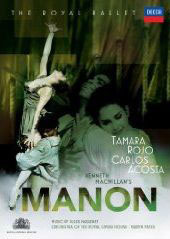 The Royal Ballet, Manon (Massenet arr Lucas/MacMillan) 2008, prod MacMillan 1974, Tamara Rojo/Carlos Acosta, ROH Orch/cond Martin Yates (Decca DEC B001362409)
The Royal Ballet, Manon (Massenet arr Lucas/MacMillan) 2008, prod MacMillan 1974, Tamara Rojo/Carlos Acosta, ROH Orch/cond Martin Yates (Decca DEC B001362409)
by Ismene Brown
Available currently only in America, but due in the UK next spring, this definitively supplants and largely eclipses the old Penney/Dowell one for its intense dramatic life and visual immediacy. As with Romeo and Juliet, the immediacy and character focus of MacMillan’s view and the cinematic swiftness of his balletic screenplay greatly suits the camera, which has a field day with all the incidental characters that populate the smelly, corrupt Paris of the story. The Rojo/Acosta partnership fuses as a partnership here than in Romeo, because while Rojo is ideal in both female roles, Acosta’s simplicity better suits Des Grieux than Romeo. So explosive and wired up in Spartacus, the glorious Cuban is here gentle, carefree and boyish at the doomed start of the Bracelet Duet - a reminder that one of his greatest qualities is his innate innocence and lack of guile as a performer.
By contrast, Rojo is both voluptuary and kitten as Manon, a delicious beauty who miscalculates how she uses it. Her initial innocence is entirely believable, you see her face register shock as she realises her brother has sold her to Monsieur GM, and yet her instant reconciliation with the new circumstances of diamonds and furs. She is serpentine and mercenary in the great pas d’action of the brothel with the eight men, arching her back orgasmically. We even notice a tiny moment caught by the camera where after Manon’s helped her lover cheat at cards two of the other girls slap her face - It’s something you wouldn't see in the stage melee but the camera makes you realise what other girls think of Manon. Such tiny details speak volumes about MacMillan's innovative ideas for ballet as theatre.
Laura Morera stands out as a witty and poignant Mistress (a role that reminds me of Musetta in La Bohème), and Tom Whitehead is a charismatic and cruel Gaoler in Act 3, but José Martin is a lightweight as Lescaut, not carrying off the “drunk” scene with sufficient comedy. Still, the camera improves the final act, turning its stage longueurs into a rollercoaster of narrative tension, and firmly leading us to the famous feverish last pas de deux in the swamps, in which Rojo and Acosta are magnificent and heartrending.
The music's patchwork works fine on film and is vividly conducted by Martin Yates, while Nicholas Georgiadis’ original designs look as hot and fetid as flames under glowing new lighting. The bonus feature is far superior to the previous Royal Ballet ones; interviews with Rojo, Acosta, Monica Mason and the film’s director Ross McGibbon which are genuinely revealing and (in Rojo’s case) entirely captivating. The talk ranges intelligently from Manon’s sexual attraction (like Marilyn Monroe’s, suggests Rojo) to the central place of sexual politics in society. Of the ballet itself, Mason says firmly that she is sure it will become as famous and durable as Swan Lake. This atmospheric recording will certainly help. Manon available in the US on hbdirect. More information from the Decca website
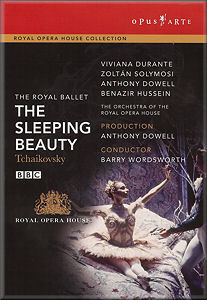 The Royal Ballet: The Sleeping Beauty (Tchaikovsky/Petipa), 1994 prod Anthony Dowell, Viviana Durante/Zoltan Solymosi, ROH Orchestra/ cond Barry Wordsworth (Opus Arte OA R3107 D)
The Royal Ballet: The Sleeping Beauty (Tchaikovsky/Petipa), 1994 prod Anthony Dowell, Viviana Durante/Zoltan Solymosi, ROH Orchestra/ cond Barry Wordsworth (Opus Arte OA R3107 D)
by David Nice
Just when the ballet conservatives thought it was safe to discard all wackiness and doze through the Royal Ballet revival of Oliver Messel’s 1946 designs, back come Maria Bjørnson’s sets and costumes for The Sleeping Beauty to be enthroned for ever on DVD.
What was so objectionable in the mid-1990s? The dancers claimed that the staircases were perilous, but only Aurora has to negotiate them choreographically on her crucial birthday-party entrance; the main stage remains as much of a forum for the Petipa display as ever. Were the costumes cumbersome? They’re certainly elaborate, the ultimate fantasy of fairies in tutus with every sequin and feather playing its part. Did the mannerist columns of a kingdom gone awry work against the line of the dancers? Surely only in a positive way.
The essence of the aristocratic imperial tradition survives intact. This is a company on peak form, with every variation, every Perrault character narrative at Aurora’s and Florimund’s wedding taken at the highest level (the Bluebird, for example, is the athletic Errol Pickford, his Princess Leanne Benjamin, later to become supreme in title roles; and you may spot Adam Cooper as one of Aurora’s supporting princes as well as a fairy cavalier). Viviana Durante’s ethereal beauty may be equalled, some would say surpassed, by Alina Cojocaru in the latest Royal Ballet DVD, but there could be no more handsome prince than Zoltan Solymosi. Anthony Dowell, who produced this ambitious but ill-fated spectacle, drags up as Carabosse but allows malevolence to triumph over camp. The emergency of the rodent entourage from under the skewed banqueting table is a typical production coup; all of the big moments, including the collapse of the giant spider web at the moment of Aurora’s kiss, are done with energy and panache.
We get much more music here than in the latest revival, even if the Sarabande remains transported to the Second Act, an inappropriate solo for a prince from the next century. This is the only production I’ve seen to feature Tchaikovsky’s 5/4 variation for the pentagram Sapphire Fairy; while Sarah Gallie’s execution makes you realise how strangely the metre sits within classical ballet, the sonorities of horns, piano and pizzicato strings are as strange as ever. The March, missing in 2006, is played as a curtainraiser, and Barry Wordsworth gives the whole score dash and continuity. Leader Vasko Vassiliev plays Aurora’s violin solos with more stylish portamento than anyone I’ve ever heard; so more’s the pity that his grand solo before a truncated "sleep entr’acte" as always gets the chop.
But ultimately it’s the mise-en-scène which keeps us dazzled through four very different acts, including a snowy forest complete with moving Panorama and a sun-king homage which ends with the fairies raised aloft above the all-seeing eye, Versailles style. Bjørnson was a genius - we shall not see her like again. Find The Sleeping Beauty on Opus Arte
 The Royal Ballet, Tales of Beatrix Potter (Lanchbery/Ashton) 2007, Royal Opera House, (Opus Arte)
The Royal Ballet, Tales of Beatrix Potter (Lanchbery/Ashton) 2007, Royal Opera House, (Opus Arte)
by David Nice
Why watch a film of the Royal Ballet’s Tales of Beatrix Potter on stage when you can luxuriate in the original 1971 film? At first I wondered: the cinematic image of a distant Mrs Tiggywinkle crossing the green fields of the Lake District has no imaginative replacement here, and the mouse waltz comes out of nowhere (the piano introduction of the original reflects a young Beatrix stumbling at the keyboard).
I’m sure, at least, that they could have made Jemima Puddleduck take startled flight from the fox-hunters, as she so splendidly does in the film, with John Lanchbery’s wonderful score sweeping upwards a semitone; here, the tableau just fizzles out. Yet from the piglings onwards, I was captivated and remained so. Whereas in the film, where Reginald Mills’s direction would seem to hamper Ashton’s effervescent steps, the momentum slows and you begin to wonder, at least as an adult, how much more of this you have to sit through, the energy of the Royal Ballet in current form, Paul Murphy conducting with brio to match Lanchbery’s own on the original soundtrack and the close-up camerawork hold the spell.
Those two bad mice, for instance, I remember as so interminably naughty when I last saw the film; and yet here Giacomo Ciriaci and Iohna Loots match the ingenuity of Lanchbery’s multiple dance strains. Ashton hardly gave Squirrel Nutkin and his russet cohort choreography worthy of the Till Eulenspiegelish mini-masterpiece, and the scene where the squirrels row out to the island on rafts is very sketchy, but the business with the old owl amuses and the set looks very pretty in an old-fashioned, painted-on-nets sort of way. Even the final picnic, interminable in the movie, mostly charms, and the tarantella curtain call clearly raises the audience’s enthusiasm to fever pitch.
The other plus, of course, is that as the tales are less consecutive than they were in the film, you needn’t watch them all at once – a bonus if you have a restless child (who may also be entertained by the little introduction of passages from the Beatrix Potter narratives). In future, I’ll be heading straight for the pig-yard as the pas de deux for Pigling Bland and his Berkshire muse still strikes me as one of the most touching achievements in ballet, as surprising as the male duo at the heart of Matthew Bourne’s Swan Lake. Here Ashton does seem to stretch the language of classical ballet to embrace porcine nimbleness as Bennet Gartside’s trots on pointe and kicks up his legs in delight alongside Laura Morera’s Pig-wig.
None of the dancers here is a star of the calibre of the film’s Tiggywinkle Ashton, Pigling Alexander Grant, squirrel-cum-bad-mouse Wayne Sleep or frog Michael Coleman, and the big head seems to minimise the leaping achievement of Zachary Faruque’s Jeremy Fisher; but essentially it’s a team effort, and that all comes together charmingly at the stories’ end. Find Tales of Beatrix Potter on Opus Arte.
Also recommended
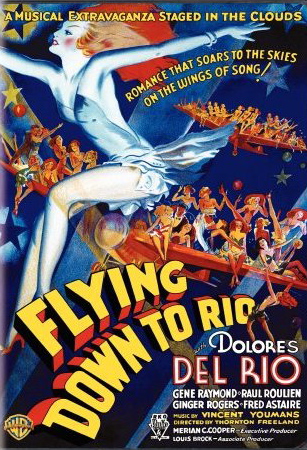 Flying Down to Rio, Thornton Freeland, 1933
Flying Down to Rio, Thornton Freeland, 1933
by Ismene Brown
Everyone will have their favourite Astaire film, and it is unlikely to be Flying Down to Rio, the first movie he made with Ginger Rogers, in 1933. It is a hilariously clumsy, naive movie, and within 18 months the pair had made The Gay Divorcé, Roberta and Top Hat. But Rio marked not just the start of the immortal partnership - it advanced the movie industry by a great leap. Astaire, wrote American critic Arlene Croce, "was technically the greatest revolutionary in the history of the movie musical. He forced camerawork, cutting, synchronisation and scoring to ever higher standards of sensitivity and precision."
Flying Down to Rio wasn’t set up as a dance movie. It was a piece of shameless production placement for a new air service between Miami and South America - the head of RKO Pictures was also a director of Pan American Airways. The leads were dusky Dolores del Rio and the white-blond Gene Raymond (black-and-white film loved this picture) but Astaire was the "entertainment", and was given unprecedented power to shoot and edit the dance numbers. There isn't that much dance in the film - unless you count the flying finale over Rio Bay with chorus-girls tied to airplanes - but the big number, the Carioca, is unforgettable, an erotic swirl of Brazilian beats and mass kitsch, pivoting on a two-minute duet for Fred and young Ginger that reads like an audition for the girl, which she passes the moment they suddenly grin at each other. You got girls on plane wings, you got white grand pianos, you got hot Brazilian beats, the divine Dolores, and Fred ‘n’ Ginger just starting out. What could be more wonderful on a cold winter's day? Find Flying Down to Rio on Amazon
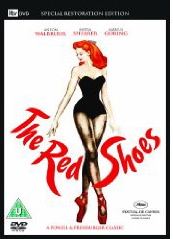 The Red Shoes, Michael Powell and Emeric Pressburger, 1948
The Red Shoes, Michael Powell and Emeric Pressburger, 1948
by Ismene Brown
You may have rushed to the cinema to see the new print of The Red Shoes, Powell and Pressburger's hallucinatory 1948 film about the compulsion of dance, in which impresario Anton Walbrook asks aspiring ballerina Moira Shearer, "Why do you want to dance?" and she ripostes, as great artists will, "Why do you want to live?" "It's cinema as music," said Martin Scorsese introducing its re-release in a newly restored print. The fairytale of the girl with evil magic shoes was written originally by Hans Christian Anderson but in this film was given an extraordinarly potent update echoing Serge Diaghilev and the Ballets Russes and exploring camera and colour with a fascinating touch of surreality. Among many interesting balletomane aspects, the performing of Swan Lake on a handkerchief-sized stage by the Ballet Rambert is historically revealing of the early conditions of British ballet, while the backstage atmosphere is dominated by the Puckish Leonide Massine. But even with no ballet interest at all you can hardly resist the supernatural colouring and spellbinding characters, Shearer's virginal glamour and Walbrook's diabolical obsessiveness. If you can't get to the cinema, buy the DVD and luxuriate in its surreal romance. Truly the laptop becomes a magic carpet when you can slide a disc like this into it and fall under a spell of strangeness. Find The Red Shoes restoration edition on Amazon.
The cinema version is scheduled for showing at London's Barbican Cinema, Mayfair Curzon, Islington Everyman, Richmond Curzon; Edinburgh Film House and Newcastle Tyneside

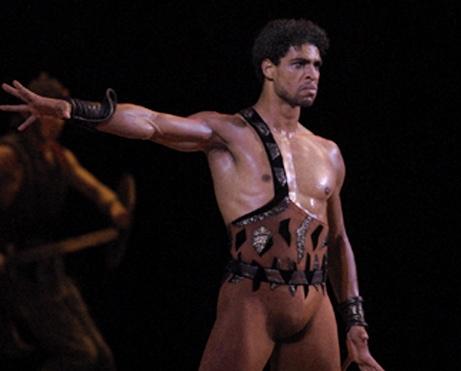












Add comment